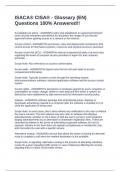Exam (elaborations)
ISACA® CISA® - Glossary (EN) Questions 100% Answered!!
- Course
- Institution
Acceptable use policy - ANSWERA policy that establishes an agreement between users and the enterprise and defines for all parties' the ranges of use that are approved before gaining access to a network or the Internet. Access control - ANSWERThe processes, rules and deployment mechanisms that co...
[Show more]



